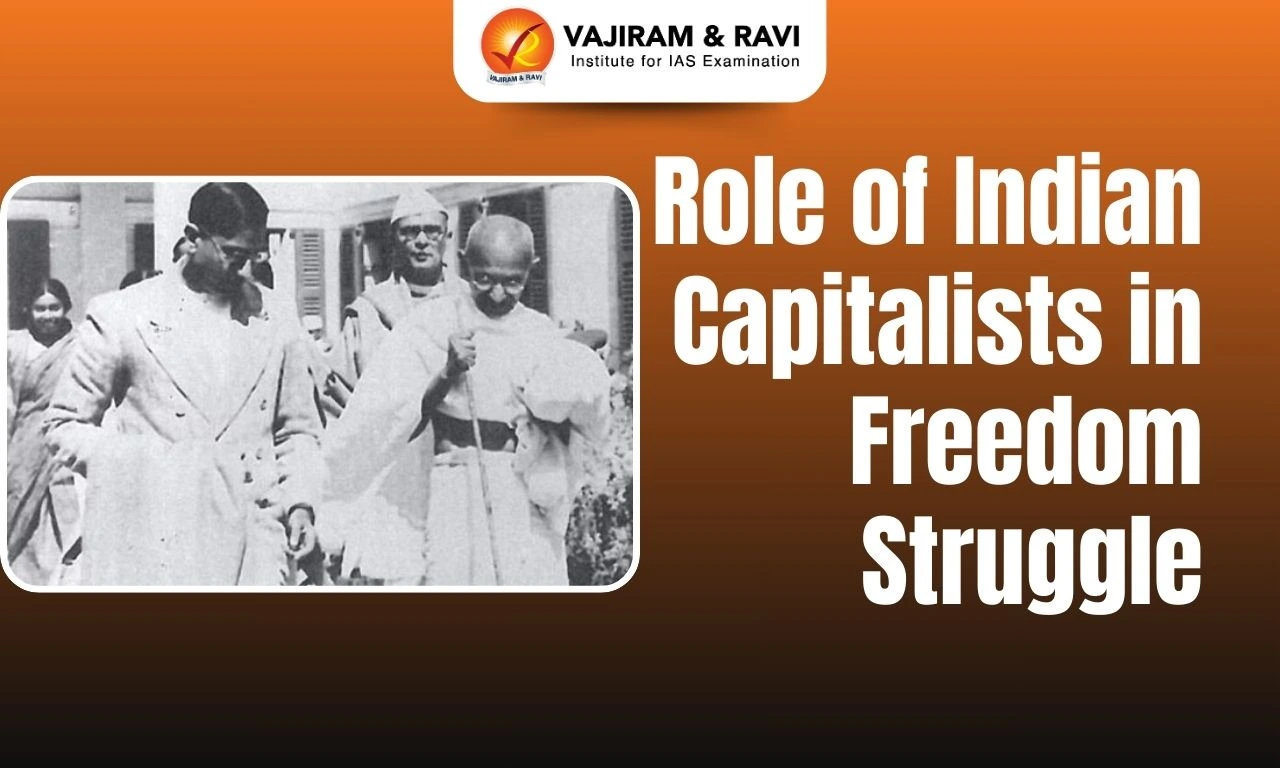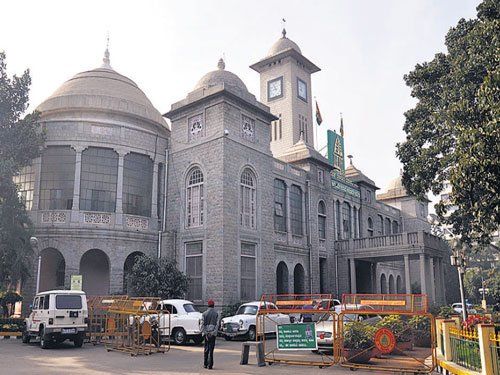Role of Indian Capitalists in Freedom Struggle: During the second half of the nineteenth century, the Indian National Movement was primarily confined to the educated middle classes. However, over time, it began to broaden its social base. In the second half of the nineteenth century, the modern capitalist class began to emerge in India. Until around World War I, there were few Indian capitalists, and their investments were small. At this stage of development, it was difficult for Indian capitalists as a class to take an openly confrontational stance towards the colonial state.
The capitalists avoided the Swadeshi Movement of 1905-1908. During the Non-Cooperation Movement (1920-22), while many traders supported it, several prominent capitalists, including Purshottamdas Thakurdas, opposed it. However, the capitalists' position shifted later on. Many Indian capitalists lent their support to the independence movement.
The Emergence of the Capitalist Class in India
The majority of early Indian industrialists arose from merchants who served as middlemen and collaborators for British businessmen.
- Big Indian businessmen and British capitalists thus enjoyed a cordial relationship in the early days, and the latter were used as models for establishing industries in India.
- The Bengal Chamber of Commerce in 1887 and the Indian Merchants Chamber of Bombay in 1907 were two examples of how Indian businessmen began to declare their independence from British capitalists by the close of the nineteenth century.
- There were few Indian businessmen up until about World War I, and the amount of their investments was also modest. Additionally, they still relied heavily on assistance from the colonial government.
- It was difficult for the Indian capitalist class to adopt an openly confrontational stance towards the colonial state at this point in their development.
- The capitalists avoided supporting the Swadeshi Movement of 1905-1908. At the time of the Non-Cooperation Movement (1920-22),while many traders participated in the movement, several eminent capitalists like Purshottamdas Thakurdas opposed the movement.
- Subsequently, however, the capitalists' position changed. Many Indian businessmen offered their support to the struggle for freedom.
Mass Nationalism and the Capitalists
There were different responses from the capitalists during the Gandhian phase of mass nationalism; in later phases, these capitalists also included industrialists, merchants, and traders.
From Rowlatt Satyagraha to Simon Commission
The industrialists and big business organisations were alarmed by the mass and agitational phase of nationalism, which began in 1918. They were alarmed as they feared a loss of business and a possible threat to the interests of capitalists. Even the few capitalists who had previously supported the movement withdrew as a result.
- Large business organisations did not support the Congress during this time.
- In fact, a large number of them actively opposed the movement and were rewarded by the colonial government with favours, such as knighthoods.
- A number of lengthy labour strikes, particularly those led by the Communists in Bombay, were another reason why the industrialists remained politically inactive.
- The millowners were drawn closer to the government out of a combination of fear of socialism and violent labour unrest.
- In their conflict with labour, the industrialists were aided by the government, and by 1930, the unions and worker agitations had been put down.
- Very few capitalists made donations to Congress, and no industrialists signed the satyagraha pledge against the Rowlatt Bills in 1919.
- Small traders and shopkeepers, on the other hand, enthusiastically supported the movement, took part in the Congress's declared hartals, and supported to its funds.
- Gandhi was aware that his call for a boycott of foreign goods would lead to profiteering by Indian industrialists. Consequently, he urged them "to conduct their business on national rather than on solely commercial lines." His appeal was ignored by the industrialists, though.
- Motilal Nehru criticised them for being ‘bent on profiting by the sufferings of the nation’.
- Some industrialists such as Jamnadas Dwarkadas, Purshottamdas Thakurdas, C. Setalvad and Cowasji Jahangir openly opposed the Non-Cooperation Movement. They formed an Anti Non-cooperation Society in Bombay.
- From 1922 onwards, however, the slump in the industry compelled most industrialists to side with Congress in its demand for protection for Indian industries.
- The millowners and the Swarajists in the Legislative Assembly both called for the abolition of the 3.5% excise duty on cotton.
- In 1927, the Indian business community established the Federation of Indian Chambers of Commerce and Industry (FICCI).
- Its main purpose was to organise India’s business interests in British India.
From Civil Disobedience Movement to Quit India Movement
When the industrial depression of the 1930s hit, the industrialists demanded that the government take strong measures to limit their losses.
- The demands of the industrialists included,
- An increase in the import taxes placed on cotton products,
- Devaluation of the rupee,
- The British cotton industries should not be given preferential treatment in Indian markets.
- All of these demands were refused by the colonial government.
- The Indian industrialists feared that the colonial government did not prioritise their interests as a result of a number of other developments.
- For instance, the 1932 Ottawa Conference gave British industries preferential treatment in the colonial markets.
- The colonial government's decision to fix the rupee-sterling ratio and link the Indian rupee to the British pound also raised doubts in the minds of Indian industrialists.
- The industrialists' dissatisfaction with the government resulted in a pro-Congress slant. The majority of their demands were included in the Congress's list as a positive response.
- However, when Gandhi restarted the CDM movement in 1932 after negotiations with the government fell through, general capitalist support for it was reduced.
- However, the growth of the left wing in the Congress and Nehru's left-leaning speeches further alienated businesspeople from the Congress.
- It wasn't until the late 1930s that Congress decided to work on the Government of India Act, 1935, that their interest in pro-Congress politics was once again piqued.
- The later phase saw the Indian capitalist class unite in their support for the moderate sections of the Congress as a result of the imperial government's conservative policies, the vocal emergence of the left-wing within the Congress, and the decline of the Congress-led mass movement.
- Thus, the Indo-British Trade Pact of 1939, which was not inherently detrimental to Indian interests, was criticised by Indian business leaders.
- The Congress and industrialists, however, decided to cooperate in the war efforts of the government.
- On the whole, the capitalists pursued the dual policy of deriving maximum benefits.
- According to Bipan Chandra, the leaders of the Indian capitalists were foresighted and skillfully handled Nehru's radicalism in the middle of the 1930s, convincing him to follow a bourgeois liberal path of development.
Post-War Period
Due to the ambivalent attitude of the Indian capitalist class it had limited a decisive influence on nationalist politics.
- By the early 1940s, when it was clear that colonial rule would end, the capitalist class had shifted to the position taken by Congress in its major policy document, the Bombay Plan, published in 1944.
- After World War II, capitalists realised the Congress might come to power; hence they became openly supportive of the Congress and even backed the idea of long-term economic planning and state control of certain industries, particularly heavy industries.
- The industrialists even supported the centrally planned economy professed by Subhas Chandra Bose and Jawaharlal Nehru, which they earlier opposed.
- The Bombay Plan: It wasdevised by the Indian capitalists in 1944 and proposed the role of a national state in the promotion of industrialisation, particularly in the areas of heavy and capital goods industries as well as in developing infrastructure.
- The Indian capitalist class recognised that it lacked the necessary resources to invest in such critical areas of the economy.
- Therefore, it emphasised the crucial role of the state’s intervention and control in such areas.
| Other Related Posts | |
| Freedom Fighters of India | Role of Working Class in the National Movement |
| Role Of Women in Freedom Struggle | Role of Indian Capitalists in Freedom Struggle |
Last updated on December, 2025
→ Check out the latest UPSC Syllabus 2026 here.
→ Join Vajiram & Ravi’s Interview Guidance Programme for expert help to crack your final UPSC stage.
→ UPSC Mains Result 2025 is now out.
→ UPSC Notification 2026 is scheduled to be released on January 14, 2026.
→ UPSC Calendar 2026 is released on 15th May, 2025.
→ The UPSC Vacancy 2025 were released 1129, out of which 979 were for UPSC CSE and remaining 150 are for UPSC IFoS.
→ UPSC Prelims 2026 will be conducted on 24th May, 2026 & UPSC Mains 2026 will be conducted on 21st August 2026.
→ The UPSC Selection Process is of 3 stages-Prelims, Mains and Interview.
→ UPSC Result 2024 is released with latest UPSC Marksheet 2024. Check Now!
→ UPSC Prelims Result 2025 is out now for the CSE held on 25 May 2025.
→ UPSC Toppers List 2024 is released now. Shakti Dubey is UPSC AIR 1 2024 Topper.
→ UPSC Prelims Question Paper 2025 and Unofficial Prelims Answer Key 2025 are available now.
→ UPSC Mains Question Paper 2025 is out for Essay, GS 1, 2, 3 & GS 4.
→ UPSC Mains Indian Language Question Paper 2025 is now out.
→ UPSC Mains Optional Question Paper 2025 is now out.
→ Also check Best IAS Coaching in Delhi

















